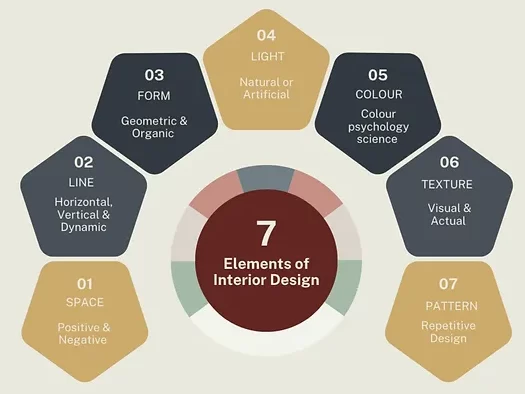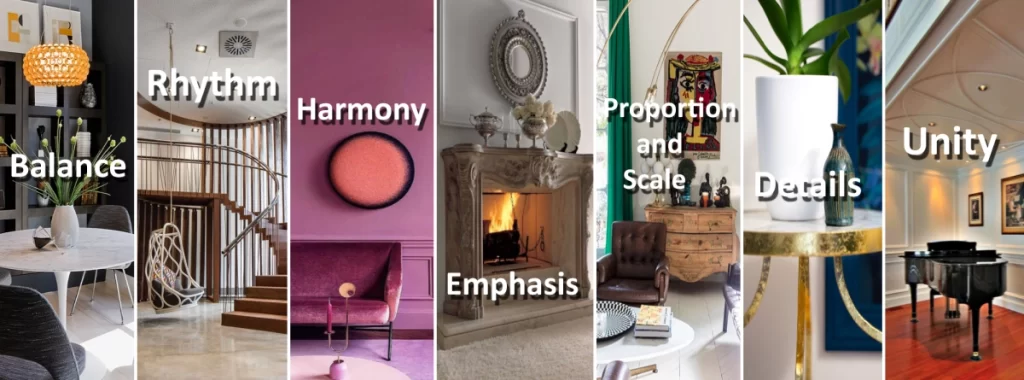Mastering the Foundations of Interior Design!

Every great interior design begins with a strong foundation—the fundamental elements and principles that bring balance, functionality, and aesthetic appeal to a space. Whether you’re an emerging designer or a seasoned professional, mastering these basics can elevate your work and ensure every project is both visually compelling and practical.
Let’s break it down.
The Building Blocks: Six Key Elements of Interior Design
Space – The foundation of any design, space consists of positive (filled) and negative (empty) areas. A well-balanced layout ensures comfort and usability. Overcrowding makes a space feel cramped, while too much emptiness can leave it feeling incomplete.
Line – Lines guide the eye and set the mood. Vertical lines, such as tall windows and doors, add height and formality. Horizontal lines, like tables and countertops, create a sense of stability, while dynamic lines, including zigzags and curves, bring movement and energy.
Form – The shape of a room, furniture, or decor. Organic forms, inspired by nature, add softness and fluidity, while geometric forms offer a structured, modern look. A thoughtful mix creates balance.
Light – Natural and artificial lighting influence both ambiance and function. Ambient lighting enhances comfort, task lighting supports usability, and accent lighting highlights focal points. Effective lighting design transforms a space.
Color – Beyond aesthetics, color affects mood and perception. Cool colors like blue and green create calmness, while warm tones like red and yellow add energy. A cohesive color scheme unifies the space.
Texture – Texture adds depth and sensory contrast. Rough textures, such as exposed brick and raw wood, bring warmth and rustic charm, while smooth textures, including glass and polished metal, exude sophistication. A well-balanced mix prevents monotony.
- Pattern – Patterns add visual interest and personality to a space by incorporating repeating shapes, colors, or motifs. Whether through textiles, wallpaper, or flooring, patterns create rhythm and movement, enhancing the overall design. A well-balanced mix of patterns prevents overwhelming the space while adding depth and character.

The Seven Principles: Making Design Work Together
Once you understand the elements, the principles guide their arrangement to create harmony.
Balance – Achieving visual stability by distributing elements evenly.
Symmetrical balance: such as mirror-image layouts, creates a classic, formal feel.
Asymmetrical balance: using different elements with equal weight, adds a dynamic touch.
Radial balance: arranging around a central point, is ideal for circular layouts.
Rhythm – The repetition of colors, shapes, or patterns creates movement and flow. Using the same accent color across pillows, rugs, and decor unifies the design.
Proportion and Scale – Elements should relate harmoniously in size. A massive chandelier in a small room feels overwhelming, while tiny decor in a vast space lacks impact. Human scale is key for comfort.
Emphasis or Focal Point – Every space needs a standout feature. Whether it is a bold accent wall, a statement chandelier, or a striking artwork, a focal point draws attention and anchors the design.
Contrast – Using opposites, such as light versus dark, smooth versus rough, and modern versus traditional, creates visual intrigue and keeps the design engaging.
Unity and Harmony – A space should feel seamless, with colors, textures, and forms working cohesively rather than competing for attention.
Details – The finishing touches, including trimmings, hardware, and textiles, bring refinement and character to a design, elevating it from good to great.

Why This Matters
Mastering these elements and principles allows designers to move beyond intuition and create intentional, well-balanced interiors. Whether designing a luxurious home or a cozy café, these fundamentals apply to every space.
Which design principle do you rely on the most in your projects? Let’s discuss.
